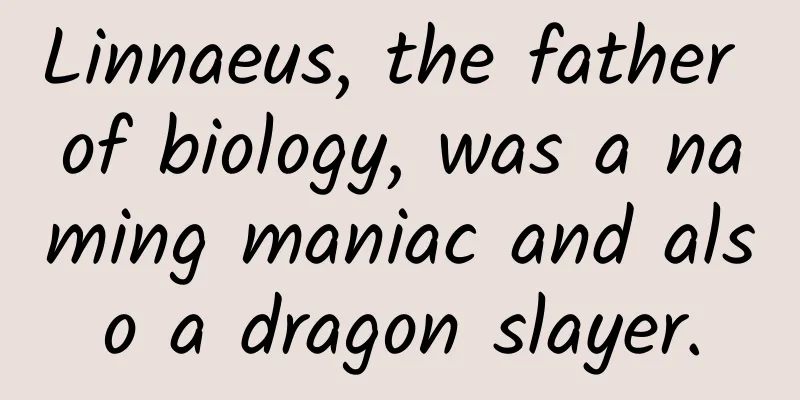Linnaeus, the father of biology, was a naming maniac and also a dragon slayer.

|
May 23 is the birthday of Carl Linnaeus, the father of biological taxonomy. As the first person to classify all the organisms in the world and the first to create biological names, Linnaeus had to name countless organisms. Although the work was hard, it was also fun. Linnaeus had a rare opportunity in human history to play with memes. Today we will introduce the unknown side of this great biologist as a "king of memes". Carl von Linnaeus | Alexander Roslin Linnaeus the Terrier Looking at the scientific names left by our ancestors, we will find many familiar names in Harry Potter and ACG. For example, Draco, which originally means dragon (Western dragon), is also the name of Malfoy in Harry Potter. The ribs of the flying lizard can be unfolded, and it uses the membrane between the bones to glide, just like a little dragon. The species name of the flying fox (Ptempus vampyrus) comes from the vampire. The flying fox is a vegetarian and does not suck blood, but its terrifying appearance makes people imagine. Flying lizards resemble small dragons | rawpixel The giant flying fox with a "ugly face but kind heart" | Dmitrij Rodionov, DR / Wikimedia Commons Linnaeus’s naming materials include not only myths and legends, but also the records of ancient scholars. The Natural History of Pliny the Elder in ancient Rome recorded two kinds of “strange fish”, the one in the Indian Sea was called balaena, and the one in the Atlantic Ocean was called physeter, which were huge and sprayed water from their heads. It is not difficult to find that the prototypes of the two monsters mentioned by Pliny the Elder were whales, so Linnaeus gave these two words to the whales he knew. He named the genus Balaena for the bowhead whale, and Physeter for the sperm whale genus. The right whale and the sperm whale were the most familiar large whales at the time, but the right whale was later placed in the genus Eubalaena. Linnaeus, who was known for his memes, sometimes felt overwhelmed by the large number of species. In 1758, Linnaeus had to name more than 200 species of butterflies at once. He used a lot of names of gods and people from ancient Greek mythology and epics, such as Hector (the hero in Homer's epic "Iliad"), Apollo, etc. He also used different camps in mythology to further subdivide butterflies of the same genus. Parnassius apollo, originally placed in the genus Papilio by Linnaeus, now in the genus Hectonichus | Hectonichus / Wikimedia Commons Taxonomists today still use a similar naming method. In 2013, scientists in New Guinea identified more than 100 new species of beetles through DNA testing. Because they were too lazy to come up with names (big mistake), they just copied names from the phone book. Linnaeus the Dragon Slayer Linnaeus’ most famous work is Systema Naturae, an attempt to catalogue all known species, which he published in its first edition in 1735. The first edition of Systema Naturae was a slim pamphlet, but not surprisingly, by the twelfth edition it had swelled to several thousand pages. For the average person, the most interesting section of the first edition of Systema Naturae is Animalia Paradoxa, which includes all sorts of fantastical creatures, such as dragons, phoenixes, and unicorns. Linnaeus categorically stated that these monsters were against common sense and did not exist. Before publishing Systema Naturae, Linnaeus saw a strange specimen in Hamburg (which was then part of the Netherlands). It had seven ugly heads and seven long necks, and the mayor thought it was a hydra. If you have watched Marvel works, you will be familiar with this term. Hydra is a nine-headed snake in Greek mythology. No matter how many heads are cut off, they will grow back. Linnaeus pointed out that this was a fake specimen made by Catholic monks using snake skin and weasel heads. It was not a hydra, but a model of the seven-headed dragon in the Book of Revelation (didn’t the mayor think the number of heads was wrong?). Illustration of the Hydra from the book by Dutch naturalist Albertus Seba | Wikimedia Commons The mayor wanted to sell the Hydra to the King of the Netherlands for a good price, and was very annoyed at Linnaeus's "nonsense". Today, it is taken for granted that "monsters do not exist", but Linnaeus' statement was quite bold. Until the 18th century, monsters like dragons were still regarded as real animals. Linnaeus' denial of the existence of monsters also shows that science is occupying the space of superstition, and the understanding of natural laws has replaced the sensational legends. Linnaeus proudly called himself a "dragon slayer". The name hydra was revived by Linnaeus. In 1740, Abraham Trembley observed hydra for the first time and was shocked. Hydra has a very strong regenerative ability. If it is cut in half, it can grow into two hydras. Linnaeus named it Hydra in 1758. If it can grow again after being cut, isn't it the same as a hydra? Hydra | Peter Schuchert/marinespecies The myth of half-man, half-monkey However, Linnaeus did not completely banish monsters from the realm of science. In the tenth edition of Systema Naturae, published in 1758, Linnaeus divided humans into Homo sapiens (that is, us Homo sapiens) and Homo troglodytes. The word troglodytes comes from the Greek word, which can be traced back to Aristotle, and means cave dweller. Linnaeus said that Homo troglodytes was a half-human, half-monkey dwarf animal with reason that lived in Ethiopia and the East Indies. In the travel notes of Europeans in Asia written in the 17th and 18th centuries, some people did mention "half-man, half-monkey". Jacobus Bontius, a Dutch doctor in the 17th century, wrote that there was a half-man, half-monkey animal in Java, which the Javanese called Ourang-Outang. Bontius believed that it was a half-man, half-beast monster in Greek mythology called a satyr. People familiar with English may recognize the word Ourang-Outang. Yes, it is the origin of the word orangutan. Orangutan | Pixabay By the way, when Linnaeus named the Bornean orangutan (Pongo pygmaeus), he also used the satyr stalk, calling it Simia satyrus, but this name has been abandoned. Today, we can easily mistakenly believe that Linnaeus believed in the existence of "half-man, half-monkey" creatures, which means that Linnaeus believed in evolution and believed that humans evolved from primates. However, the tenth edition of Systema Naturae was published a hundred years earlier than Origin of Species, which means that the theory of evolution was still far from being born. Early biologists believed that everything can be arranged from low to high, from the lowest organisms to the highest gods, which they called the Great Chain of Being. "Half-human, half-monkey" is a link between "animals" and "humans", which is why Linnaeus believed it existed. Unlike the idea of evolution, all links in the "chain of life" are immutable. The world imagined by Christianity is divided into different levels, from hell to plants, animals, humans, and at the top is heaven | Wikipedia Linnaeus gave the name "half man, half monkey", the long and strange word troglodytes, which still survives as a monster. In "Dungeons & Dragons" and "Heroes of Might and Magic", there are monsters named troglodytes. Johann Friedrich Blumenbach, a scientist of the same period as Linnaeus, gave this word to the species name of the chimpanzee Simia troglodytes, the closest relative of humans (the genus name was later changed to Pan), which was considered to be a face to Linnaeus. Artist: Wang Pichai Author: Little Wombat Editor: pee pee shrimp References [1] Lopezalles, Sierra MacKenzie. The Evolution of Dragons: From Living Serpents to Mythical Beasts. Diss. California Institute of Technology, 2020. [2] Yang Yanbin. "The "White Races of the African Interior": Scientific Knowledge and Classical Literature in the Eighteenth Century." Journal of History, National Taiwan Normal University 41 (2009): 109-140. [3] (UK) Leo Ruykerby, translated by Jiu Yu. Fantasy Zoo[M]. Chengdu: Sichuan People's Publishing House, 2018. This article comes from the Species Calendar, welcome to forward If you need to reprint, please contact [email protected] |
<<: Wake up, there is no food in the world that makes you thinner the more you eat it!
>>: Urgent reminder! Don’t eat this kind of fruit on the roadside!
Recommend
What are the functions of the Amusement Park mini program? How much does it cost to develop a group buying app for a children’s playground?
The mini program has been online for more than 5 ...
Tech Neo May Issue: Deep Learning
51CTO Network+ Platform launched the "TechNe...
Expert summary! 8 principles to help you quickly improve page usability
Editor's note: Whether designing a website or...
2019 Internet Marketing Promotion Tips!
With the gradual improvement of current Internet ...
Can dieting and losing weight "starve" tumors to death? Some people really do this, and the result is...
"You can 'starve tumors' by dieting&...
These 5 types of people are more likely to get cancer! If you are in this situation, be sure to take precautions!
There are always people asking what kind of peopl...
Analyst: Apple wants to simplify the naming of new iPhones and no longer use numbers
According to Appleinsider, Robert Cihra, an analy...
Advertising: 5 factors affecting exposure
The first step in advertising is to gain exposure...
"100 times" charger is born! Let the mobile phone be fully charged in 1 minute
Is it possible to charge your phone from 0% to 100...
From "building houses" to "supporting bamboo shoots", Chinese scientists pioneered a new method for crystal preparation
▲The picture shows electronic and photonic integr...
Inositol, is it really that magical?
This is the 4774th article of Da Yi Xiao Hu Recen...
An advertising optimization “magic tool” that increases delivery results 10 times!
The job of an information flow advertising optimi...
The popular information flow advertising, how does it work?
Information feed ads first appeared on Facebook i...
Offline event planning and traffic diversion skills!
Nowadays, the Internet dividend period has long d...









